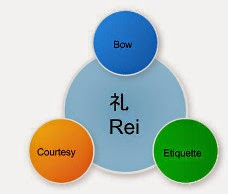I wrote this about judo, but it applies just as well to every other budo I’ve seen.
I watched the young guns at judo going at it like they were hammering each other on an anvil. They were working hard fighting each other strong and fast, with all the strength and speed they have. Young guys really work at their judo. The referee called out “Hajime!” and they grabbed each other, started attacking, doing everything they could to throw each other. In no time they were panting from the effort. I was getting tired just from watching them. They were really working hard to throw each other.
It took a while, but eventually even the strength and stamina of youth wear out, and the guys on the mat needed break. Granted, they lasted at least twice as long as I would have trying to work that hard, but they still wore themselves out. After the young guys bowed off the mat and headed for a water break, the referee turned to Harold and I and invited us to take their places. Harold and I are a couple of middle-aged guys who’ve been doing judo for a while.
The referee yelled “Hajime!” Harold took a step forward, held out his hands in invitation, tilted his head and smiled at me. This was pure “old fellow judo.” Harold didn’t want to attack hard and give me any energy I could use against him. He also didn’t want to work like those young guys had been doing. Neither one of us has that kind of stamina anymore. Besides, one of the maxim’s of Judo is “Maximum efficiency, minimum effort” and Harold understands that. I keep trying to get my ego to understand it too, so I stepped forward a little, held out my hands to make my sleeves easy to grab, and smiled back.
We stood there smiling at each other for a moment, then we gingerly reached out for each other without committing any energy that could be used against us. As we moved around the dojo it felt a lot more like a dance than a fight. As you become more skilled you become less eager to throw energy at your partner because he’s more than happy to accept it and do something with it. We moved with a complete awareness of this, so instead of the fast, sudden movements of the young guys, we old fellows moved slowly and smoothly.
The young guys put a lot of effort into it out there, pushing and pulling on their partner, working to make a technique happen. Harold held my dogi lightly and we moved gently around the dojo looking for opportunities to work our partner’s movement. I’ve learned from being thrown far too many times that if I push hard into someone, or pull on them, an experienced partner is just as likely to get out of the way of my push and toss me over onto the mats as not.
Harold and I were trying to feel what was happening and what the other was doing. Neither one of us was trying to make our partner do something. We were moving around the dojo. Our goal is to feel what our partner is doing and help them do more of it. We moved around the room, our feet sliding across the mats, never stepping. A nice, big, John Wayne type step is an invitation to be thrown with everything from a simple and subtle foot sweep to a great big, literally over-the-top seioinage throw. Harold and I studied each other. He has a dropping seioinage that he likes, and I’m working on a interesting ouchigari. We’ll both take a nice footsweep though if it’s available.
So we moved around the mat, occasionally making little attacks, going after foot sweeps when our partner’s structure felt a little bit off or trying to add some energy to their movement to destabilize them and create an opportunity for some other technique. The young guys are constantly trying to do a technique to their partner. They are working hard to do some judo. Old fellows know better than to rush. We’re patient and we wait for it to happen.
Good judo techniques aren’t forced. You can’t make them happen. If you’re making something happen, you’re not doing judo. It’s that old “maximum efficiency minimum effort” thing. Don’t make something happen. It’s more like letting something unfold naturally. If you’re trying to force your will on the situation, it’s not great judo. Oh, you might be able to force a technique to happen, but that’s not very high level judo. The best judoka don’t have an intention of what’s going to happen. They let their partner decide how they will be thrown. There are lots of ways of describing what is happening. You flow with partner’s energy or match their intent or blend with them. The young guys try to do judo. They push on uke and pull on him and try to make him react or just force their way to a place where a technique can be done. The old fellows just let it happen.
Old fellows don’t work too hard. The best techniques sneak up on the person being thrown and suddenly the floor is slapping them between the shoulders. A foot sweep happens when uke is moving and their partner adds some energy to their foot and changes its direction so that instead of settling on the ground and supporting his weight, uke’s foot ends up over on the other side of their body while their weight continues down to the ground in the original direction. There are lots of ways to get to this technique. When I was learning this, (yeah, I really was a young guy once) I would jerk on my partner’s arm trying to yank them forward to I could sweep their foot. Now I just wait for the weight shift and add a little energy to the foot and draw gently on their arm in the direction they are already moving. At least that’s what I try to do. Harold feels for a forward weight shift, draws on the arm that’s moving forward, drops and turns underneath the arm and does a neat drop seioinage. No fighting with your partner, no strength opposing strength.
To me, the finest judo techniques are de ashi harai and uki otoshi. Neither one can be forced. You have to use what your partner is already doing and just guide their inertia. This video is a beautiful example. Uke tries to drive in to do ouchigari. Instead of resisting the force, his partner works with it, slips out of the way and guides the energy from uke in a spiral so uke goes from standing upright to horizontal facing up and falling to the floor. This is not a technique where the person executing it adds a lot power or puts a lot of effort into what is happening. On the contrary, you have to get out of your own way. It’s pure old fellow judo.
It’s funny. Old fellows can keep at it in randori for quite a while. They don’t waste a lot of energy pushing and pulling at their partner. They are just there, quietly, calmly, patiently moving around the room with their partner, not fighting them, no trying to make anything happen. The young guys keep pounding away at you, working hard at their judo expending incredible amounts of energy. The old fellows are there, relaxed and happy, gently moving around the dojo deflecting all that excess energy and throwing their partner from time to time when they are able to guide some of that exuberant energy in a way their partner doesn’t want but can’t prevent. It’s kind of amazing, but old fellows are so much more efficient than young guys that we can stay out and do a 5 minute randori session with people 25 or 30 years younger than we are, and not be any more out of breath than the young guys.
It only looks like we’re keeping up with the young guys though. Old fellows aren’t really keeping up with them. Old fellows just flow along on the current of energy being thrown out by the young guys without resisting it, so the old fellows are using a fraction of the energy the young guys are expending. It can be interesting watching a someone more than 60 years old playing with a college student and realizing that while the college student has youth, speed, strength and stamina in their favor, the old fellpw is the one who going easy on his partner, as he smiles through the randori, and gently tosses the young guy to the ground.
It’s that old seiryoku zenyou, maximum efficiency minimum effort. Old fellows just don’t have as much energy as the young guys do, but what we have, we use a lot more efficiently. Old fellows aren’t there for a short stint. They’ve been around a while and plan to to be around for a lot longer. They have to make what they’ve got last for the long haul. There are lots of people to do randori with, and we want to play with them all. Old fellows really enjoy practice. They aren’t working at, they are playing with it, in the best sense of the word. They are playing with the techniques and timing to see what works and what they can do. Old fellas have been thrown by everyone, so they don’t mind getting thrown when they make a mistake, and they are thrilled when a younger student figures out a lesson and applies it to them, even when that means taking a big fall. It’s fun to see others make progress. After a while, all that ego that used to scream that we have to throw everyone goes away and we can simply enjoy the randori, whether we are the ones doing the throwing, or the ones being thrown.
Young guys work at it and need to throw everyone. Old fellas play with whatever they get, and even when they are thrown, they’re smiling.



